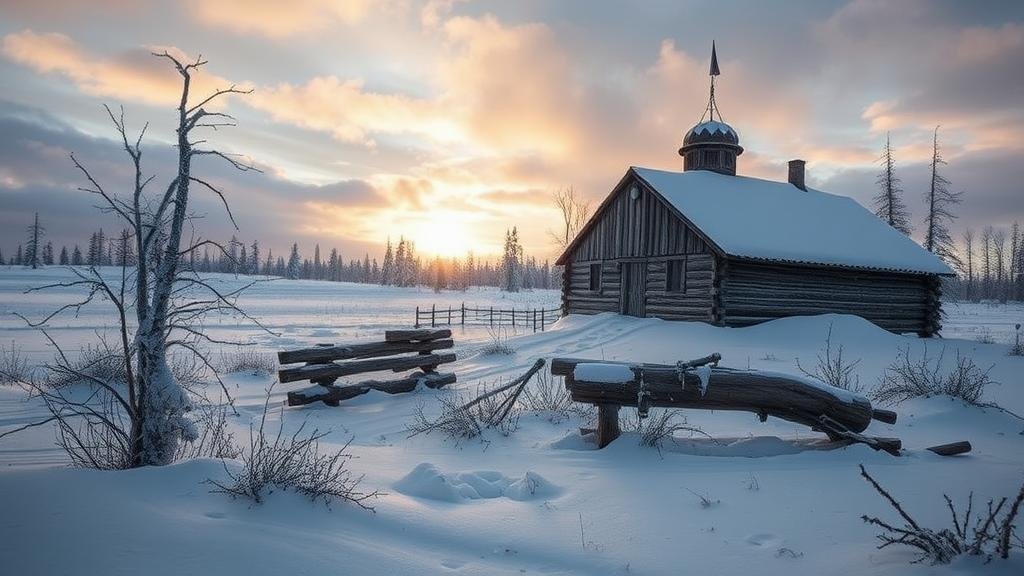Exploring the frozen ruins of Zeleniy Gorodok, a lost Siberian trading post.
Exploring the Frozen Ruins of Zeleniy Gorodok, a Lost Siberian Trading Post
In the vast and inhospitable expanse of Siberia lies the enigmatic trading post of Zeleniy Gorodok, a site steeped in mystery and history. Once a bustling center of trade, this lost settlement now serves as a haunting reminder of the regions rich past, shrouded in the frozen remnants of a bygone era. This article delves into the history, significance, and exploration of Zeleniy Gorodok, bringing to light the stories hidden beneath layers of ice and snow.
Historical Background
Zeleniy Gorodok was established in the 17th century, around the year 1670, during Russias expansion into Siberia. This trading post was strategically located along the trans-Siberian trade routes, facilitating exchanges between Russian settlers and indigenous peoples, including the Evenki and Yakuts. By the early 18th century, Zeleniy Gorodok became a key trading hub, primarily dealing in furs, a valuable commodity at the time.
As the fur trade flourished, the population of Zeleniy Gorodok grew, attracting merchants, craftsmen, and travelers from far and wide. But, by the late 19th century, the rise of new trade routes and the decline of the fur industry led to the gradual abandonment of the post. By the early 20th century, Zeleniy Gorodok was all but forgotten, left to be claimed by nature and the harsh Siberian climate.
The Ruins Today
Today, Zeleniy Gorodok is a ghostly landscape, where the remnants of wooden structures peek through the blanket of snow. Archaeological investigations have revealed various artifacts that provide insights into the lives of those who once inhabited this trading post. These artifacts include:
- Fur trade implements, including traps and tools
- Cooking utensils and pottery, suggesting a community-centric lifestyle
- Russian coins and other trade goods, indicating extensive commerce
The ruins are not only fascinating from a historical perspective, but they also provide valuable data for climate scientists studying how permafrost impacts cultural heritage sites. preservation of materials, thanks to the freezing temperatures, offers a unique opportunity to learn about the everyday lives of past inhabitants.
Challenges of Exploration
Exploring Zeleniy Gorodok presents numerous challenges due to its remote location and extreme weather conditions. The site is located approximately 1,500 kilometers northeast of Moscow, deep in the Siberian wilderness. Temperatures can plummet to -40°C in winter, thwarting attempts at lengthy expeditions. Also, the terrain is often treacherous, with deep snow and unpredictable weather conditions posing risks even to seasoned explorers.
Despite these hurdles, recent technological advancements have made exploration possible. Drones equipped with thermal imaging and high-resolution cameras are now utilized for aerial surveys, helping researchers identify structural remnants and map the area efficiently. Also, advancements in remote sensing technology allow scientists to analyze underground structures without disturbing the fragile environment.
Real-World Applications and Future Research
The ongoing research at Zeleniy Gorodok serves several important purposes:
- Contributing to the field of archaeology, enhancing our understanding of Siberias historical trade networks
- Providing valuable insights into the socio-economic conditions of indigenous populations during the fur trade era
- Offering a case study for climate scientists observing the effects of climate change on permafrost and its implications on archaeological sites
As researchers continue to unearth the stories behind this frozen post, it highlights the importance of preserving such sites. With global warming rapidly changing the environment, initiatives for the protection and conservation of places like Zeleniy Gorodok are crucial for future generations.
Actionable Takeaways
If you are interested in supporting the exploration of Zeleniy Gorodok or similar sites, consider the following actions:
- Follow organizations dedicated to archaeology and climate preservation that conduct research in Siberia.
- Engage in educational programs that promote awareness about indigenous cultures and historical trade routes in Russia.
- Support sustainable tourism practices that prioritize the preservation of historical sites and respect for local communities.
Exploring Zeleniy Gorodok not only provides a glimpse into a significant historical trading post but also emphasizes the ongoing relationship between humanity and our changing environment. With continued exploration and research, we can uncover the secrets that this frozen landscape holds while ensuring its protection for future generations.


